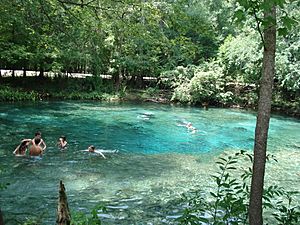Ginnie Springs facts for kids
Quick facts for kids
Ginnie Springs
|
|
|---|---|
|
Park
|
|
 |
|
Ginnie Springs is a beautiful, privately owned park in Gilchrist County, Florida, USA. It is located about 6.5 miles (10.5 km) northwest of High Springs. The park sits right next to the Santa Fe River, and its clear, cool water flows into the river. Underneath the water, you can find amazing caverns with sandy and limestone bottoms.
Contents
Exploring Ginnie Springs
Ginnie Springs has been a popular spot for visitors for many years. The Wray family has owned this park since 1971, and they opened it to the public in 1976.
A Place for Divers
In the mid-1990s, scuba diving became very popular. Bob Wray, the owner, opened the springs for divers to explore. To help keep divers safe, he added a metal grate over a challenging part of the cave. He also put up warning signs for divers. Ginnie Springs quickly became famous as a top diving spot, and it is still very popular today.
Fun Activities in the Water
Today, there are many exciting things to do at Ginnie Springs. Besides diving, visitors can swim, snorkel, canoe, and kayak. You can also try stand-up paddleboarding or tube along the Santa Fe River. The river has several springs where you can jump in and cool off. The water in the springs is very clear, so it is easy to see fish and other wildlife. You can also see the plants growing underwater.
Water for Drinking
The clear water from Ginnie Springs is so pure that it is even used for bottled spring water. You might have seen water from this area sold as bottled spring water.
Protecting the Water Source
Recently, a company was given permission to take a lot of water from the underground source that feeds Ginnie Springs. This source is called an aquifer. The company plans to take over 1.1 million gallons of water every day. Many people around the world are worried about this. They are concerned about how taking so much water might affect Ginnie Springs and other nearby springs.
River Tubing Adventures
Ginnie Springs is one of the best places in Florida for river tubing. Floating down the Santa Fe River from Ginnie Springs usually takes about one hour. The water near the springs is a cool 72 degrees Fahrenheit (22 degrees Celsius). The water in the wider river is a bit warmer. Since Ginnie Springs is privately owned, it has fewer rules than some other parks. For example, tubers can use tubes of any size they like.
Camping Under the Stars
Ginnie Springs is also well known for its camping areas. If you want to stay overnight, you can reserve a campsite with water and electricity. There are 129 of these campsites, and they are located across from the park's store. If you prefer a more natural camping experience, you can choose a primitive campsite. These do not need a reservation, but they are available on a first-come, first-served basis.


